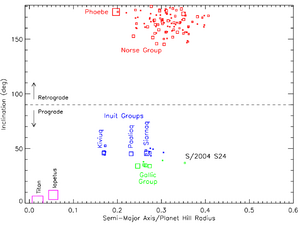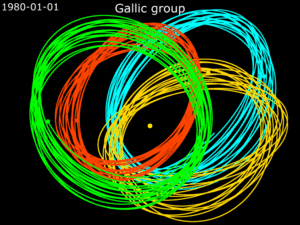Gallic group facts for kids

The Gallic group is a collection of moons that orbit the planet Saturn. These moons are known as "irregular satellites" because their paths around Saturn are not perfectly round. They also travel in a "prograde" direction. This means they orbit Saturn in the same direction that Saturn itself spins.
These moons share similar orbits. Their average distance from Saturn is between 16 and 19 million kilometers. Their orbits are tilted between 35° and 40° compared to Saturn's equator. Also, their orbits are quite stretched out, with an eccentricity of about 0.53.
The International Astronomical Union (IAU) is the group that names planets and moons. They have decided that moons in the Gallic group will be named after characters from Gallic mythology.
Contents
How the Gallic Moons Formed
Scientists believe the moons in the Gallic group might have come from one larger object. This object likely broke apart a long time ago. This idea came from seeing how similar their orbits are.
Later, scientists also found that these moons look alike. They all have a slightly reddish color. This color is similar to what you might see on a light-red brick.
Albiorix's Unique Colors
Interestingly, recent observations showed something different about Albiorix. Albiorix is the largest moon in this group. It actually shows two different colors on its surface. One color matches the other moons, like Erriapus and Tarvos. But another part of Albiorix is less red.
This discovery changed the idea of how the group formed. Instead of one big object breaking into many pieces, scientists now think something else happened. They believe that Tarvos and Erriapus might be pieces that broke off from Albiorix. This could have happened when a large object crashed into Albiorix.
Such a crash would have needed a space rock bigger than 1 kilometer (about 0.6 miles) across. It would have hit Albiorix at a very high speed. This impact would have left a large crater on Albiorix, about 12 kilometers (7.5 miles) wide. We know such collisions happened in Saturn's past. For example, the moon Phoebe has many very large craters.
Discovering New Moons
In October 2019, a team of scientists announced they had found 20 new moons orbiting Saturn. This discovery was made using the Subaru Telescope in Hawaii. One of these new moons, named S/2004 S 24, also orbits Saturn in a prograde direction. However, it is much farther away from Saturn than the other Gallic moons. Even so, this moon will also be given a name from Gallic mythology.
Members of the Gallic Group
Here are the known members of the Gallic group. They are listed in order of how far they are from Saturn:
Other Prograde Moons
There are three other prograde moons that have a similar tilt to the Gallic group. However, their orbits are much farther away from Saturn. These moons are:
- S/2006 S 12
- S/2004 S 24
See also
 In Spanish: Grupo Gálico para niños
In Spanish: Grupo Gálico para niños


